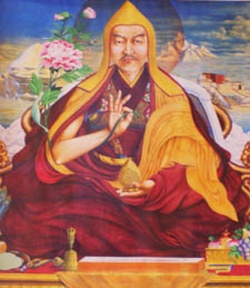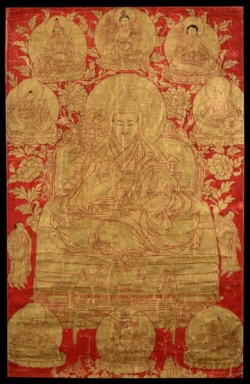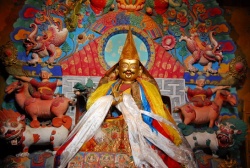Difference between revisions of "The Fifth Dalai Lama Gains Power over Tibet"
(Created page with "thumb|250px| <poem> Just as historical buildings in Lhasa are becoming sparser by modern development, so are accounts of Trode Khangsar’s origin. A...") |
m (1 revision: Umber tostmine VTao) |
||
| (2 intermediate revisions by one other user not shown) | |||
| Line 1: | Line 1: | ||
| − | [[File:5thDalaiLama.jpg|thumb|250px|]] | + | [[File:5thDalaiLama.jpg|thumb|250px|]][[File:5th Dalai Lama.jpg|thumb|250px|]] |
<poem> | <poem> | ||
| − | Just as historical buildings in Lhasa are becoming sparser by modern development, so are accounts of Trode Khangsar’s origin. A short chronology and a background of the key figures here will clarify the events leading up the founding of Trode Khangsar. The Fifth Dalai Lama, Ngawang Lobsang Gyatso (1617-1682), was the first Dalai Lama to hold temporal power in Tibet. Earlier in his life the influence of the short-lived empire in the neighboring region of Tsang (gtsang) exerted its control over central Tibet (dbus) and was at odds with the affairs of the Gelug sect in both regions (AOK, 32-39). | + | Just as historical buildings in [[Lhasa]] are becoming sparser by {{Wiki|modern}} development, so are accounts of [[Trode Khangsar’s]] origin. A short {{Wiki|chronology}} and a background of the key figures here will clarify the events leading up the founding of [[Trode Khangsar]]. The [[Fifth Dalai Lama]], [[Ngawang Lobsang Gyatso]] (1617-1682), was the first [[Dalai Lama]] to hold temporal power in [[Tibet]]. Earlier in his [[life]] the influence of the short-lived [[empire]] in the neighboring region of [[Tsang]] ([[gtsang]]) exerted its control over {{Wiki|central Tibet}} (dbus) and was at odds with the affairs of the [[Gelug]] sect in both regions (AOK, 32-39). |
| − | The Fourth Dalai Lama, Yonten Gyatso, was Mongolian and his incarnations came to be revered by the Mongolians. Sonam Rabten was the Fifth Dalai Lama’s associate7 since his recognition at childhood (FDL, 256). He sought the help of the Qoshot Mongols to intervene in the situation in Tibet (HPP, 447). Eventually the Mongol leader Gushri Khan came to Tibet and proceeded to overthrow the king of Tsang, Karma Tenkyong Wangpo (kar ma bstan skyong dbang po), in 1642. | + | The [[Fourth Dalai Lama]], [[Yonten Gyatso]], was {{Wiki|Mongolian}} and his [[incarnations]] came to be revered by the {{Wiki|Mongolians}}. [[Sonam Rabten]] was the [[Fifth Dalai Lama’s]] associate7 since his [[recognition]] at childhood (FDL, 256). He sought the help of the Qoshot {{Wiki|Mongols}} to intervene in the situation in [[Tibet]] (HPP, 447). Eventually the Mongol leader [[Gushri]] {{Wiki|Khan}} came to [[Tibet]] and proceeded to overthrow the [[king]] of [[Tsang]], [[Karma Tenkyong Wangpo]] ([[kar ma bstan skyong dbang po]]), in 1642. |
| − | Effective power was granted from Gushri Khan, who retained the title of | + | Effective power was granted from [[Gushri]] {{Wiki|Khan}}, who retained the title of “[[King]] of [[Tibet]],” to the [[Fifth Dalai Lama]] through appointment of various governors8 (sde sri) (HPP, 448). The [[Fifth Dalai Lama]] traveled to [[China]] to meet with the Qing [[Emperor]] in 1652 which sealed his [[recognition]] of sovereignty9 (FDL, 263). Other {{Wiki|military}} campaigns went eastward to [[Kham]] and seized control of [[Ngari]], {{Wiki|Western}} [[Tibet]] from Ladakh’s control (TGF, 13). As a result, the provinces of {{Wiki|Central Tibet}}, [[Kham]], [[Tsang]] and [[Amdo]] all came under the control of the newly-created [[Tibetan]] government, called the [[Ganden]] Phodrang, under the [[leadership]] of the [[Dalai Lama.]] |
| − | 7 The term “associate” is used due to the number of roles he assumed in his relation to the Fifth Dalai Lama and the Tibetan government, Ganden Phodrang. Ahmad’s translation of Desi Sangye Gyatso’s biography of the Fifth Dalai Lama notes that Sonam Choepel, who is also called Sonam Rabten, was present when the Dalai Lama first came to Drepung when he was 6 years old. He was also the treasurer for the Fourth Dalai Lama, Yonten Gyatso, at the end of his life, which led Sonam Choepel to be involved in recognizing his successor. | + | 7 The term “associate” is used due to the number of roles he assumed in his [[relation]] to the [[Fifth Dalai Lama]] and the [[Tibetan]] government, [[Ganden Phodrang]]. Ahmad’s translation of [[Desi Sangye Gyatso’s]] {{Wiki|biography}} of the [[Fifth Dalai Lama]] notes that [[Sonam Choepel]], who is also called [[Sonam Rabten]], was present when the [[Dalai Lama]] first came to [[Drepung]] when he was 6 years old. He was also the treasurer for the [[Fourth Dalai Lama]], [[Yonten Gyatso]], at the end of his [[life]], which led [[Sonam Choepel]] to be involved in [[recognizing]] his successor. |
[[File:5th Dalai Lama38.jpg|thumb|250px|]] | [[File:5th Dalai Lama38.jpg|thumb|250px|]] | ||
| − | 8 According to Richardson, the title | + | 8 According to Richardson, the title “{{Wiki|king of Tibet}}” was kept by the [[Gushri]] {{Wiki|Khan}} and his descendents who provided armed [[protection]] to the [[Dalai Lama.]] The [[Dalai Lama]] was to be the [[spiritual]] leader and appointed various governors (sde sris) to manage the state affairs. It appears these various roles were never clearly defined and as a result most likely lead to the Qoshot {{Wiki|Mongolian}} resumption of power in [[Tibet]] by Qoshot [[Wikipedia:Lha-bzang Khan|Lhazang Khan]], a descendent of [[Gushri]] {{Wiki|Khan}}, overthrowing and killing [[Desi Sangye Gyatso]] over 50 years later. |
| − | 9 Again this is a sensitive interpretation of the significance of this event. On one hand, its significance is downplayed by those who assert Tibet’s independence over China. On the other hand, it is an event that clearly indicates the Fifth Dalai Lama’s rise to sovereignty. | + | 9 Again this is a sensitive interpretation of the significance of this event. On one hand, its significance is downplayed by those who assert [[Tibet’s]] {{Wiki|independence}} over [[China]]. On the other hand, it is an event that clearly indicates the [[Fifth Dalai Lama’s]] rise to {{Wiki|sovereignty}}. |
| − | Trode Khangsar: | + | [[Trode Khangsar]]: |
| − | Dorje Shugden’s Ornament in Lhasa’s Mandala | + | [[Dorje Shugden’s]] Ornament in Lhasa’s [[Mandala]] |
Introduction | Introduction | ||
| − | Lhasa Real Estate: Location, Location, Location | + | [[Lhasa]] {{Wiki|Real}} Estate: Location, Location, Location |
| − | Lhasa’s Inner Sanctum | + | [[Lhasa’s]] Inner Sanctum |
| − | The Role of a Tsen Khang or Protector House | + | The Role of a [[Tsen Khang]] or [[Protector House]] |
| − | The Fifth Dalai Lama Gains Power over Tibet | + | The [[Fifth Dalai Lama]] Gains Power over [[Tibet]] |
| − | The Fifth Dalai Lama and his Peer, Tulku Dragpa Gyaltsen | + | The [[Fifth Dalai Lama]] and his Peer, [[Tulku Dragpa Gyaltsen]] |
| − | A Spiritual View of This Incident: the Birth of Dorje Shugden | + | A [[Spiritual]] [[View]] of This Incident: the [[Birth]] of [[Dorje Shugden]] |
| − | Trode Khangsar is Offered to Dorje Shugden by the Fifth Dalai Lama | + | [[Trode Khangsar]] is [[Offered]] to [[Dorje Shugden]] by the [[Fifth Dalai Lama]] |
| − | Riwo Choling Monastery: Sangye Gyatso’s Sabbatical | + | Riwo Choling [[Monastery]]: Sangye Gyatso’s Sabbatical |
| − | Trode Khangsar: the Protector House Itself | + | [[Trode Khangsar]]: the [[Protector House]] Itself |
| − | Trode Khangsar throughout History | + | [[Trode Khangsar]] throughout History |
Conclusion | Conclusion | ||
Images | Images | ||
| Line 35: | Line 35: | ||
[[Category:Buddhist Terms]] | [[Category:Buddhist Terms]] | ||
[[Category:5th Dalai Lama]] | [[Category:5th Dalai Lama]] | ||
| + | [[Category:Trode Khangsar]] | ||
Latest revision as of 07:58, 2 November 2013
Just as historical buildings in Lhasa are becoming sparser by modern development, so are accounts of Trode Khangsar’s origin. A short chronology and a background of the key figures here will clarify the events leading up the founding of Trode Khangsar. The Fifth Dalai Lama, Ngawang Lobsang Gyatso (1617-1682), was the first Dalai Lama to hold temporal power in Tibet. Earlier in his life the influence of the short-lived empire in the neighboring region of Tsang (gtsang) exerted its control over central Tibet (dbus) and was at odds with the affairs of the Gelug sect in both regions (AOK, 32-39).
The Fourth Dalai Lama, Yonten Gyatso, was Mongolian and his incarnations came to be revered by the Mongolians. Sonam Rabten was the Fifth Dalai Lama’s associate7 since his recognition at childhood (FDL, 256). He sought the help of the Qoshot Mongols to intervene in the situation in Tibet (HPP, 447). Eventually the Mongol leader Gushri Khan came to Tibet and proceeded to overthrow the king of Tsang, Karma Tenkyong Wangpo (kar ma bstan skyong dbang po), in 1642.
Effective power was granted from Gushri Khan, who retained the title of “King of Tibet,” to the Fifth Dalai Lama through appointment of various governors8 (sde sri) (HPP, 448). The Fifth Dalai Lama traveled to China to meet with the Qing Emperor in 1652 which sealed his recognition of sovereignty9 (FDL, 263). Other military campaigns went eastward to Kham and seized control of Ngari, Western Tibet from Ladakh’s control (TGF, 13). As a result, the provinces of Central Tibet, Kham, Tsang and Amdo all came under the control of the newly-created Tibetan government, called the Ganden Phodrang, under the leadership of the Dalai Lama.
7 The term “associate” is used due to the number of roles he assumed in his relation to the Fifth Dalai Lama and the Tibetan government, Ganden Phodrang. Ahmad’s translation of Desi Sangye Gyatso’s biography of the Fifth Dalai Lama notes that Sonam Choepel, who is also called Sonam Rabten, was present when the Dalai Lama first came to Drepung when he was 6 years old. He was also the treasurer for the Fourth Dalai Lama, Yonten Gyatso, at the end of his life, which led Sonam Choepel to be involved in recognizing his successor.
8 According to Richardson, the title “king of Tibet” was kept by the Gushri Khan and his descendents who provided armed protection to the Dalai Lama. The Dalai Lama was to be the spiritual leader and appointed various governors (sde sris) to manage the state affairs. It appears these various roles were never clearly defined and as a result most likely lead to the Qoshot Mongolian resumption of power in Tibet by Qoshot Lhazang Khan, a descendent of Gushri Khan, overthrowing and killing Desi Sangye Gyatso over 50 years later.
9 Again this is a sensitive interpretation of the significance of this event. On one hand, its significance is downplayed by those who assert Tibet’s independence over China. On the other hand, it is an event that clearly indicates the Fifth Dalai Lama’s rise to sovereignty.
Trode Khangsar:
Dorje Shugden’s Ornament in Lhasa’s Mandala
Introduction
Lhasa Real Estate: Location, Location, Location
Lhasa’s Inner Sanctum
The Role of a Tsen Khang or Protector House
The Fifth Dalai Lama Gains Power over Tibet
The Fifth Dalai Lama and his Peer, Tulku Dragpa Gyaltsen
A Spiritual View of This Incident: the Birth of Dorje Shugden
Trode Khangsar is Offered to Dorje Shugden by the Fifth Dalai Lama
Riwo Choling Monastery: Sangye Gyatso’s Sabbatical
Trode Khangsar: the Protector House Itself
Trode Khangsar throughout History
Conclusion
Images
Sources and Abbreviations
Images 2009


